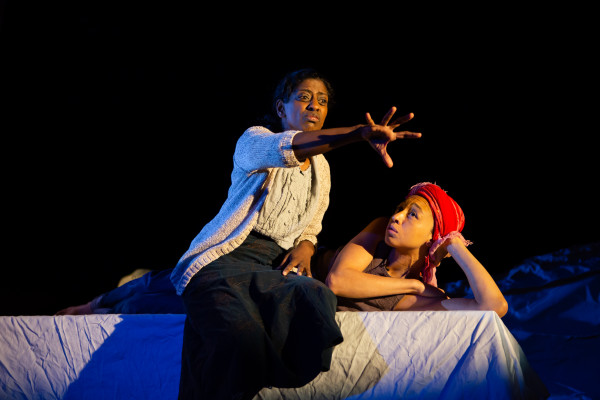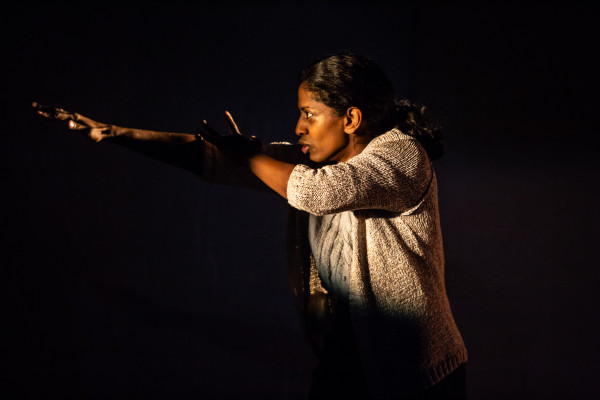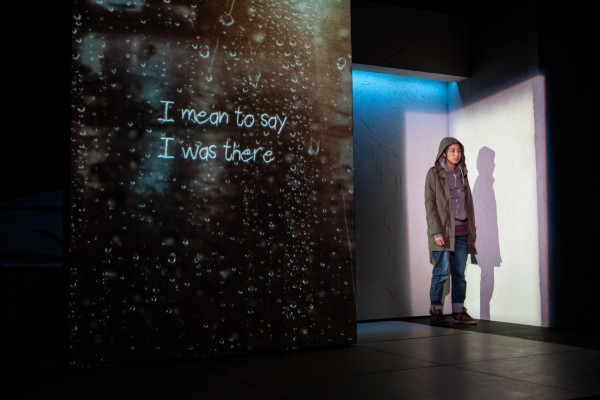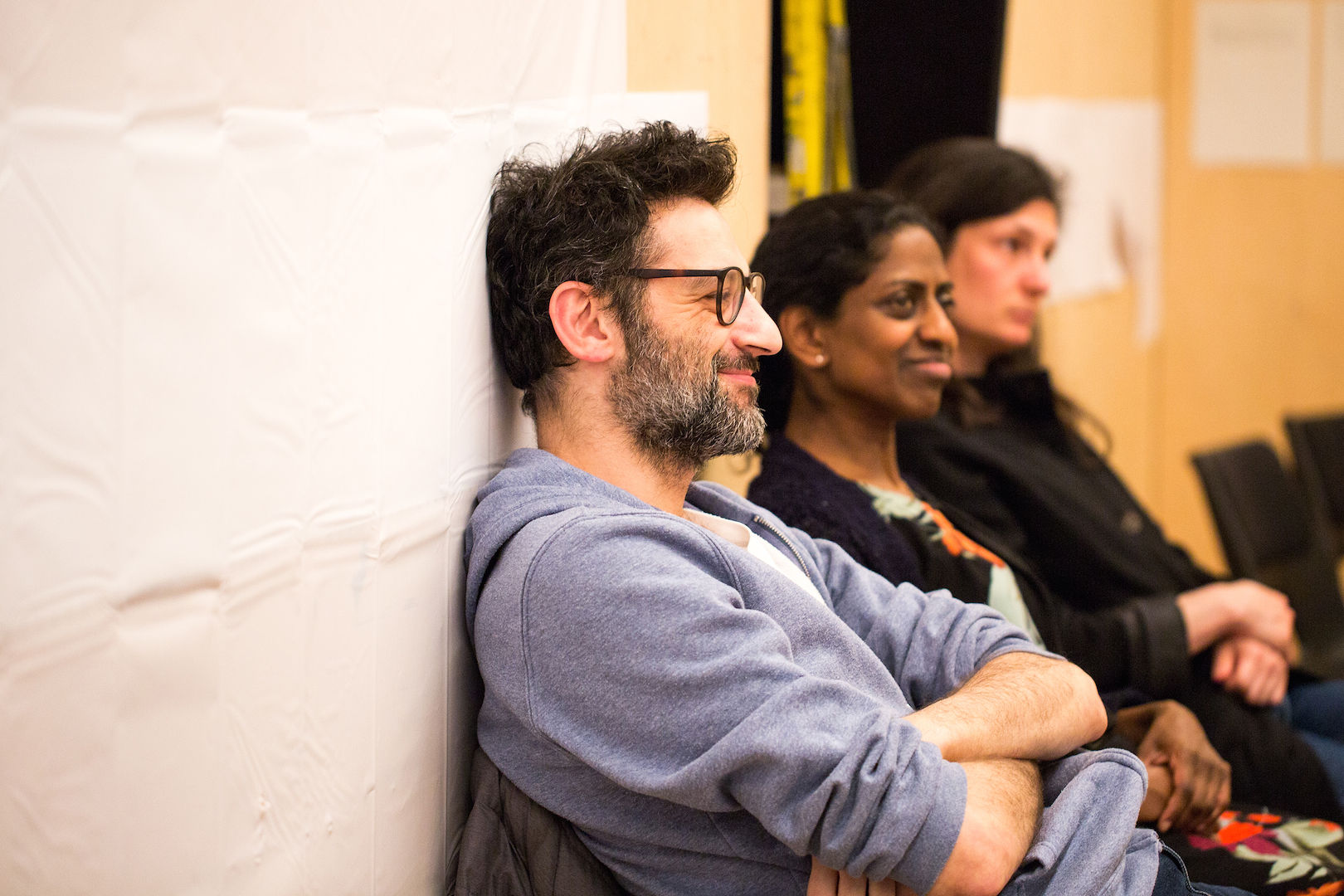Accessibility in Theatre: Telling d/Deaf Narratives
Thu 11 Apr 2019 |
Our People, Our Plays, The Bigger Picture
Accessibility in storytelling lies at the heart of Omar Elerian’s direction of Going Through.
In the UK, 1 in 7 of the population are deaf or hard of hearing, with over 156,000 people using BSL nationwide. However, in spite of the vast number of d/Deaf individuals in Britain, inclusion in the national theatre landscape is few and far between.
Going Through directly tackles this issue by aiming to make all performances equally accessible to hearing and deaf audiences. Led by Omar Elerian (director of the West End hit Misty), the critically acclaimed production mixes English, British Sign Language (BSL), and Creative Captioning for its vibrant storytelling.
Omar sits down to discuss his approach as director, the significance of the play, and why he thinks audiences will enjoy it.
How does d/Deafness feature within the play?
One of the two characters is a deaf woman who takes care of a hearing child, raising her and teaching her sign language in a non-specified country that we learn is being ravaged by war. So the communication between the two is mostly in sign language, but at one point the girl leaves and enters the hearing world to find her birth mother. It’s at this point where sign language progressively disappears from her communication and affects the way she relates to the world.
The show has been described as striving to be “equally accessible” to both hearing and deaf audiences, what steps has the production taken to make this happen?
The production features sign language, spoken word, creative captions and relies heavily on video imagery, so the combination of these four elements and languages on stage will weave seamlessly throughout. At different moments one of these four languages will take the lead, but throughout we will create a journey that is quite complimentary between the four.

Nadia Nadarajah & Charmaine Wombwell in Going Through. Photography by Ali Wright
Can you elaborate a little on what Creative Captioning means?
Captioning is the subtitling that you see in videos online or on film that would just replicate the words that are being spoken by a performer in real time. Creative Captioning is a way of doing that, but has the capacity to respond a bit more to the emotional concept of the scene. For example, words and projection don’t necessarily have to be in the same space, the size of the words could be different, or arranged without block sentences. Our captions don’t have to follow the script word for word, and have the potential to go along with the rhythm of the performers, rather than just punctuating or translating what is being said.
As a hearing director, what did you want to ensure you got right?
First of all, I wanted to make sure that the sign language was precise and that it reflected the emotional world of the characters, and that’s why I have worked with a deaf Associate Director, Louise Stern. We are also working with Charmaine Wombwell, who is a hearing actress but is the child of deaf parents and is fluent in BSL, and Nadia Nadarajah whose mother-tongue is BSL.
We have spoken a lot about where to pitch the language. For example, the characters have grown up in quite an isolated community and would have had lots of familiar signs between themselves. This meant that there was a question of whether to use straight BSL, or work in BSL-based language that played on the relationship between them. We spent a lot of time on these sorts of questions, and making sure that both hearing, and BSL-using audiences learn the way that these two communicate with each other, rather than just translating the play as it is on the page into a different language.

Nadia Nadarajah in Going Through. Photography by Ali Wright
How has Going Through required you to alter your style of direction?
The creative relationships on this project have greatly altered my style of direction, as certain decisions and ideas about how to stage certain moments and create a visual space meant doing the job at many different levels and layers. For example, the team were tasked with incorporating video projections and what these communicate on stage, and how that compliments the imagery that is created through sign language.
Also, being aware through Deaf Awareness Training that there is a whole bandwidth: there is not only BSL or non-BSL users, there are people at different levels of sign language, there are deaf people who don’t use BSL and rely heavily on captions, while others are fluent in BSL but struggle with captions in English. I think that finding the point of balance in between these different experiences for the audience was an interesting exercise.

Charmaine Wombwell in Going Through. Photography by Ali Wright
Your rehearsal room is a mix of hearing and deaf cast and creatives. How has your experience been collaborating in the rehearsal room with this mix of languages?
It took us a little while in the beginning as a mostly hearing team to be able to understand how to work with never less than 4 interpreters in the room. Also, Louise Stern’s native language is American Sign Language (ASL), so we had two ASL and two BSL interpreters and at the beginning there was a lot of back-and-forth about who was voicing what, and the best way to translate all these different languages. But I think the more we worked, the more we found a way of communicating which became more fluid. We found that we needed interpreters less once the concepts and the staging ideas became shared with the rest of the team, it became a lot easier not to have to rely on so many words to explain things, but say, ‘oh this thing we just did, can we do it in this way’, and everyone would understand.
How do you hope the show will impact the audiences that come to see it?
It is a really touching and heart-warming story about love and separation so in a way, it speaks universally to the human experience. While the characters in it may be a deaf woman and a child that uses sign language, the story is about love and migration and the travails and challenges that a migrant child faces, leaving her home and country in order to find a better life and the sacrifices of the woman who raised her. So that’s what I hope people will be touched by, because it’s a version of a story we have heard many, many times in different contexts and different languages and different times. It truly tells us about the big struggles and challenges that generations of people have gone through in order to flee hardship.
Going Through is at the Bush Theatre until 27 April






